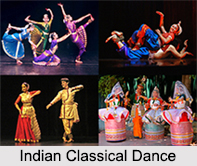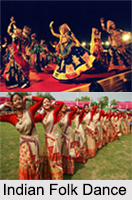 Types of Indian Dances reflect the rich ethos of the subcontinent. With their sheer intricacies, the different types of Indian dances bring out the innermost feelings and emotion, whilst depicting the cultural aspects of the age-old civilization of India. Like all other aspects of life, the dance forms of India are also varied and different. There are many types of dance forms in India, from those which are deeply religious in content to those which are performed on small occasions.
Types of Indian Dances reflect the rich ethos of the subcontinent. With their sheer intricacies, the different types of Indian dances bring out the innermost feelings and emotion, whilst depicting the cultural aspects of the age-old civilization of India. Like all other aspects of life, the dance forms of India are also varied and different. There are many types of dance forms in India, from those which are deeply religious in content to those which are performed on small occasions.
Origin of Dance in India
The origins of dance in India go back to the earliest paleolithic and neolithic cave paintings such as the Bhimbetka rock shelters in Madhya Pradesh. Several sculptures excavated from archaeological sites of the Indus Valley civilization indicated the existence of dance as an art since 2500 BCE. Many ancient texts on arts have also mentioned dance and music including the Vedas, Shatapatha Brahmana, Shashtras, etc.
Classification of Types of Indian Dances
Based on the style, dash, intricacies and elan, Indian dance can be broadly classified into four types like, Classical Indian dance, Indian Folk dance, Tribal dance and the Fusion dance. Classical dances in India are expressive practices that are documented and traceable to ancient classical texts, particularly the Natya Shastra. This art form has been associated with a school or guru-shishya parampara.
Folk dances are largely originated from oral tradition like folklores that are passed through generations. A semi-classical Indian dance is one that contains a classical imprint but has become a folk dance and lost its texts or schools. A tribal dance is a more local form of folk dance, typically found in one tribal population
Indian Classical Dances
Indian Classical Dances are also known as the traditional Indian dance. They are in abundant forms and take human figure as its basic medium of expressions. Dance performed inside the temple chamber, imperial courts along with music are classified as classical dance. The foundation of the conventions and methodical movements and types of this dance lies in an ancient book of dance, music and, drama called "Natyashastra". The Indian classical dance style is unique in terms of movement, grace, style and elan. The major Indian classical dances are as follows:
Bharatnatyam: Bharatnatyam is one of the oldest forms of classical dance which has its origin in Tamil Nadu. It is inspired from the sculptures of the ancient temple of Chidambaram. Bharatnatyam is considered to be a mystic manifestation of the metaphysical element of fire in the human body. It is a solo dance with two aspects, the graceful feminine movements and also the masculine motion.
Kathakali: Kathakali originated in Kerala. It is a classical Indian dance-drama known for its attractive make-up of characters, detailed costumes, gestures and well-defined body movements. It is considered to be a combination of dance, music, playing of instruments and drama.
Kathak: Kathak is a dance form which has its origin in Northern India. It has the influences of Bhakti movement, Persian dance and Central Asian Dance. This dance form traces its origins to the nomadic bards of ancient northern India, known as Kathaks, or storytellers.
 Kuchipudi: Kuchipudi is a dance form of Andhra Pradesh. It has derived its name from a village in Krishna District where the Brahmins used to practice this art. It has bright and quick movements. One of the major attractions is where the dancer has to dance on the brass plate with two diyas, one in each hand while balancing a small vessel containing water on the head.
Kuchipudi: Kuchipudi is a dance form of Andhra Pradesh. It has derived its name from a village in Krishna District where the Brahmins used to practice this art. It has bright and quick movements. One of the major attractions is where the dancer has to dance on the brass plate with two diyas, one in each hand while balancing a small vessel containing water on the head.
Mohiniyattam: Mohiniyattam, also known as dance of enchantress, is a major art form in Kerala performed only by women. It has its influences from Bharatnatyam and Kathakali. Mohiniyattam is basically a drama in dance and poetry.
Manipuri: Manipuri dance, as the name suggests is the foremost dance form of Manipur. Its main theme is Raslila. The conventional Manipuri dance style symbolizes delicate, poetic and poised movements. Its facial and bodily movements are restrained.
Odissi: Odissi has its origination in Odisha and is considered to be one of the oldest dance forms in India as per the sculptural evidences. Odissi was initially performed in the temples as a religious offering by the "Maharis" who dedicated their lives in the services of God.
Sattriya: Sattriya is a striking dance of Assam. This was a way of disseminating to people about mythological stories in a simple manner. Sattriya Nritya emerged from the sanctum of Assam`s sattras.
Indian Folk Dances
Indian Folk Dances have originated with a view to be a creation of different socio-economic set up and traditions. Indian folk dances are simple and performed to express joy and also to celebrate any season, festivals and so on. Many folk dances are devoted to the presiding God of the specific community. The most appealing element of a folk dance is the requisite outfit for its performance. In Indian Folk Dances, the accessories play a vital role, these costumes provide a separate identity to the folk dance. Many a time, folk dances are termed as per the name of the accessory used.
Folk dances of Northern India: There are various folk dances seen around the states of north India, and some even transcend state boundaries to integrate with the culture of the neighboring states. These folk dances are Chhapeli dance, Choliya Dance, Naqaal, Swang, Jhummar, Teeyan, Dhamal, Bhangra, etc.
Folk dances of Southern India: Folk dances from the Southern part of India are known to imbibe the finest elements of the history and culture prevailing in South India. Some of the significant folk dances of southern India include Kummi, Padayani, Dhimsa, Bathukamma, Mayilattam, Theyyamm, Yakshagna, Kolaattam dance , Bayalata, Bhootha Aradhane dance, and Kummattikali.
 Folk dances of Eastern India: Folk dances of East India have great historical significances as almost all dance forms are several hundred years old. Notable folk dance forms of eastern India are Chhau Dance, Gotipua, Dalkhai, Gambhira dance, Jhijhian dance, Kirtan dance, Santhal dance, Lathi dance, Bidesia dance, and Paika Dance.
Folk dances of Eastern India: Folk dances of East India have great historical significances as almost all dance forms are several hundred years old. Notable folk dance forms of eastern India are Chhau Dance, Gotipua, Dalkhai, Gambhira dance, Jhijhian dance, Kirtan dance, Santhal dance, Lathi dance, Bidesia dance, and Paika Dance.
Folk dances of Western India: Known for its rich culture and heritage, West India is home to a variety of several folk dance forms. Both men and women folks hog the limelight when it comes to folk dance. Some of the significant folk dances of Western India are Dandiya, Garba, Tippani dance, Bhavai dance, Ghoomar, Kalbeliya, Khayal dance, Dindi, Dekhni dance, Koli, and Dulpod dance.
Folk dances of Northeastern India: The vibrant culture and rich tradition of folk dances from North East India is an attractive feature of their cultural history. These dances include Wancho Dance, Bihu Dance, Zeliang Dance, Pung Chalom Dance, Nongkrem Dance, Bagurumba Dance, Cheraw Dance, and more.
Folk dances of Central India: Associated with different festivals and rituals, folk dances of Central India have an incredible charm. These dances are a reflection of the rich cultural heritage of Madhya Pradesh, Chhattisgarh, and their bordering states. Folk dances of central India include Maanch, Gaur Maria dance, Charkula Dance, Karma dance, Madai dance, Lakshmi Jagar, Lota dance, Panthi Dance, and Raut Nacha to name a few.
Indian Tribal Dances
Indian Tribal Dances are dances by adivasis or tribes of the land. These dance forms are based on completely different culture from the larger Indian population. The most important aspect of tribal culture is music and dance. Dance and music are primarily meant to propitiate Gods and Goddesses. In social functions, tribal dance is performed in a central place of the village. Each tribe has its own pattern of dance and music.
Tribal Dance in Southern India, Northern India, Eastern India, Western India, Northeastern India, and Central India are distinct to their culture, style, and performance. Some of the prominent tribal dances include Wancho Dance, Ponung Dance, Zangtalam Dance, Hozagiri Dance, Kabui Dance, Santhali dance, and Dollu Kunitha Dance.
Indian Fusion Dance
Indian Fusion Dance is a new dance trend that has developed in India in the recent era. The modern forms of dances are the fusion of the various traditional dance forms. Sometimes, dances are composed in artistic forms with old songs and sometimes remixed music for choreographed dance. Salsa and ballet troupes are eventually becoming popular trends in the domain of dance. These days film dance has also carved a niche for itself in the domain of dance in modern India. This is a mixture of classical and folk dance, which has given birth to a semi-classical form. Film dances are a vital element in most Indian films for entertaining the audience.
With a prolific tradition, Indian dance takes human figure as its basic mechanism of expression. Indian dance amidst its expression and poise therefore reflects the deep philosophy and the religious mood of India to a great extent.



















